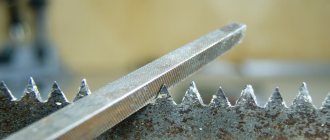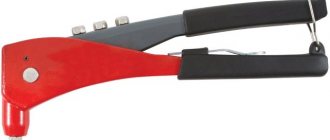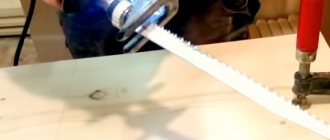In construction or in everyday life, various materials and equipment are often used to connect two structures. In the professional sphere, the main method of bonding metal is welding, but for home use, a universal tool is suitable - a riveter. This device is actively used for reliable adhesion of various materials, guaranteeing strength and durability, while the price does not hit the wallet too hard. In the article we will consider the main questions that may arise for those who like to do everything with their own hands, and the editors of YaNashla present to your attention a rating of the best riveters for 2022.
What is a riveter and the purpose of its use
The main purpose of a riveter is to join two materials using a rivet. A special design is installed in the finished holes, which allows you to connect almost anything for a long time. Before connecting two parts, the location where the rivet will be installed is marked. After this, a hole is drilled in two materials. A rod - a rivet - is inserted directly into the axially aligned hole, and the clutch is made using special equipment - a riveter.
This tool is used in many cases, in everyday life, construction, installation. The riveter does not require much knowledge during operation, but without specific instructions and a description of the work, it is unlikely that it will be possible to complete the correct process. Therefore, before deciding to buy such a device, it is necessary to carefully study the principle of its operation and presumably determine what materials the work is planned to be used on. By the way, not only the tool itself depends on the type of material, but also the mandatory presence of special rivets.
Practical recommendations
Possible options when working with the device:
- Parts of different thicknesses; all work is done from the side of the material with a smaller thickness, to reduce the likelihood of its deformation.
- If this is not possible, install a support washer.
- Use fasteners with an enlarged skirt on the side of the soft part.
- Use petal, spacer or plastic fastening elements.
- They use “blind” rivets that do not allow dust, water, or fumes to pass through.
- There must be at least 2 hole diameters to the edge of the part.
Tip: By squeezing and unclenching the tool, you can easily pull out the stuck rod. Make sure it doesn't fly out the other side.
Equipment Specifications
The mechanism of the riveter is practically no different from its type of use - professional or amateur. Its design includes the following components:
- a main body which includes a handle;
- at the end of the body there is a special head necessary for installing the rod (rivet);
- a lever made in the form of a handle with a lever mechanism;
- inside the structure there is the mechanism itself with a sleeve, which engages the rivet with the materials;
- spring.
In appearance, this tool may resemble pliers with a hint of a construction gun.
The adhesion of materials is achieved by squeezing two handles together.
Positive and negative aspects of the device
The tool is widely used in many areas, but where high adhesion conditions are not required.
The positive features of a riveter include the following:
- easy to use and does not require much physical effort;
- inexpensive in price and also requires budget consumables;
- when bonding materials with this type of equipment, no special surface cleaning or treatment with degreasing agents and other construction details are required;
- due to its small dimensions it is easy to use in hard-to-reach places;
- adheres to almost all alloys and materials, as well as wood, plastic and other types of structures;
- operation does not require additional, sometimes harmful, adhesive substances, and the tool can be used in any climatic conditions.
Despite the obvious advantages of the tool, there are also equally important negative aspects:
- unfortunately, this type of clutch does not guarantee durability;
- there is no complete tightness;
- if the material is made of thin sheets, then the structure is weakened by drilling holes;
- the appearance of the rivet is not very aesthetic.
the tool has more positive qualities, which makes it possible to use it at home without the use of expensive and difficult-to-use equipment, and the riveter is a safer way to adhere materials.
Bottom line
If you need to connect 2 solid materials, then riveting is the most optimal method today. This method is widespread both in professional fields, such as construction and large-scale production, and in the domestic sphere. The riveting method is popular due to its efficiency and solid joint quality. It is easier for the average owner to make a paper clip than to weld. In addition, this method does not require professional skills and is relatively cheap.
Definitely, a riveter is an indispensable tool in a home craftsman’s collection. Its advantages are obvious, but it is not obvious how to choose the most optimal model among the great variety of them. Pros recommend paying attention to the following details:
- What is the body made of? A device made of plastic is only suitable for one-time work. Such instruments are cheaper, but cannot provide a guarantee of quality. If the user is interested in long-term use of the riveter, it is better for him to choose from steel models.
- Functional range and basic kit. The wider the range of acceptable rivet sizes, the better the device. Ideally, it should also be equipped with a container for collecting waste elements. The package must consist of at least a set of attachments.
- How much does the device weigh? The more weight, the more professional the model. Amateur-grade instruments can weigh less than 1 kg.
- Brand reputation. Before purchasing a particular riveter, it is better to read online reviews about the manufacturer’s name. The tool market is very wide and it is better to make a choice based on the brand’s reputation.
The selection made in accordance with the above points guarantees the quality of the purchase. The range of riveters is large, it allows you to choose the most optimal option for each case.
The main criteria for choosing a riveter
In order to choose the best tool, you need to decide on some criteria that are worth paying attention to:
- Purpose of use. Two purposes are defined:
- professional use - for such purposes, purchase a device that has a wide range of different types of rivets, as well as the ability to adjust the compression;
- home use - devices that are simple in design, inexpensive and do not require much effort, which are used to connect 3-4 types of rivets.
- Construction mechanism and appearance.
- one-handed - small-sized tools that are used in hard-to-reach places; the only drawback of such equipment is that you will have to make maximum effort to compress, which causes rapid fatigue from work;
- two-handed - they may vary in the length of the handles, but they are more multifunctional for work, because the effort will be minimal and the grip will be stronger.
- Technical capabilities of the working mechanism with or without rotation function. These can be stationary or mobile.
- in mobile mechanisms it is possible to rotate the housing head, which allows you to work in tight spaces;
- combined type of mechanism - the tool has the ability to rearrange positions in two degrees 0 and 90;
- the stationary mechanism assumes that the riveter is always in one position, without the possibility of rearranging the head.
- Additional functions. Depending on the manufacturer and cost, the device may include replaceable attachments that allow you to expand the possibilities of using the tool.
- The connecting rod is rivets. There are different types of rivets on the market, but not all can fit a particular tool. Today there are two types of coupling rod:
- blind rivets - are rods with a smooth head, during the adhesion process the end of the rivet is flared (deformed), made of aluminum, steel and copper;
- threaded rivets - for strong and durable adhesion, as is clear from the name, the rods have a special thread into which self-tapping screws and molly dowels are screwed, but this type requires special attachments.
- Tool material. Budget options made from fragile material will not allow the parts to be held together firmly, since significant physical strength is required to squeeze the handles. The most common case materials include: stainless steel or aluminum alloys.
Which riveter to choose
There are several types of tools for joining parts using rivets. According to the method of using energy, it can be manual, electric or pneumatic. The first option is in demand in everyday life and small workshops as an auxiliary device.
The second and third ones, due to their high productivity and tangible cost, are more suitable for continuous production. In this article we will focus on manual models and their differences related to the design features of the consumable.
For blind or threaded rivets
In modern technology, two types of rivets are most widespread: blind and threaded. In order not to have problems finding consumables, experienced craftsmen purchase a tool adapted to work specifically with them.
Riveter for blind rivets
Principle of operation. A blind rivet consists of a hollow sleeve with a flat stop on one side and a rod inserted into it with a slight expansion at the end. The protruding edge of the rod is securely captured by the collet holder of the rivet gun. The sleeve is placed all the way into the aligned holes of the parts to be joined, after which the pulling mechanism of the tool is activated.
The relatively soft metal of the hollow part of the rivet is crushed, shortening and filling all the free space at the installation site. The part that protrudes outward, which has become unnecessary, comes off when a certain force is reached.
Operating principle of a blind rivet machine.
Application. Typically, this type of rivet tool is a universal one. It is equipped with interchangeable heads adapted for rivets of different sizes.
Replaceable nozzles of various sizes.
Due to high loads, the main elements of riveters are made of alloy steel grades. For manual models, the design of the lever mechanism is of great importance, which is more powerful, the higher the diameter of the consumable.
Devices of this type are used to create permanent connections of dissimilar flat parts or structural elements to which welding is not applicable. They provide an advantage when working in inconvenient places or when the connection point is accessible only from one side.
Riveter for threaded rivets
Principle of operation. A threaded rivet has the form of a hollow tube, one edge of which is flared to increase the outer diameter, and the other end has an internal thread. The metal of the central part of the bushing is thin, so if you screw a pin into it and pull it towards you, it will crumple, securely fixing the device inside the hole intended for it.
Operating principle of a riveter for threaded rivets.
Application. Riveters of this type have a device for installing specially shaped studs with different thread diameters and a lever mechanism for retracting them. They are used when it is necessary to make a strong threaded connection in a thin-walled part for attaching additional elements to it.
How to decide on the type of riveter design
Depending on the type and intensity of work performed, riveters of different designs are selected. Manufacturers offer hand tools in three designs.
One-handed rocker-type riveters
This tool is designed to be used with one hand. The second is then released to secure the workpiece or securely hook the operator onto a support in an inconvenient installation location or at a height. For such a riveter, the handles are usually located perpendicular to the axis of the exhaust mechanism. One of them is part of the body, and the second plays the role of a movable lever.
The force generated is sufficient to install rivets with a diameter of up to 6.4 mm. Such models usually contain a device for accurately cutting the shank.
One-handed riveter of rocker type.
Two-handed riveters
Two-handed riveters use the force of both hands and look like pliers. They have large levers with comfortable handles. The developed force is enough to work with rivets with a diameter of up to 14 mm.
Two-handed riveters.
Types and characteristics of the device
What types of riveters are there? The table shows the types of tools.
| Name | Varieties | Characteristic |
| Power type | Manual | The appearance resembles ordinary pliers, with rubberized handles. Performance will be determined depending on physical effort |
| Battery or electric | The energy of this type of riveter is aimed at impact and formation of the rivet. The appearance is similar to a pistol, as there is a button on the body. made in the form of a trigger, and runs on mains power or battery | |
| Pneumatic | More professional tools, as they have greater productivity and a complex mechanism. | |
| Rivets | Length and diameter | Under working conditions, it is worth determining the thickness of the parts to be fastened, on which the size of the rivet will depend. If you choose the wrong length, the head will not deform correctly and the grip will not be strong, and sometimes not at all. The main thing when choosing consumables is to choose not only the size of the rivet, but also to be sure that it will fit the tool. |
| Manufacturer | Russian made | BISON, BARS |
| Foreign made | Gross, Kraftool, STANLEY |
Rating of the best riveters for 2022
The rating of quality products will help answer the question: which is the best tool to buy for the home and how much the best models cost. The review presents popular tool models based on customer reviews and the opinions of professionals.
Riveter Kraftool 31170-H6
Classic design for blind rivets. Suitable for rods with diameters: 2.4 mm, 3.2 mm, 4 mm, 4.8 mm, made of steel, aluminum and stainless steel. The package includes: a case, a set of coupling rods in the amount of 60 pieces, various attachments and an adjustable key for changing them 10 mm. The handle body material is made of rubber and plastic. Average price: 1000 rubles.
Riveter Kraftool 31170-H6
Advantages:
- large set of nozzles;
- ability to work with 4 types of rivets;
- convenient storage;
- low price;
- famous brand.
Flaws:
- plastic handles.
Riveter STANLEY MR55 0-69-804
Used to work with blind rivets with diameters: 3 mm, 4 mm, 5 mm, 2 mm. The material of the rods should be made of copper, steel, ordinary and stainless steel, aluminum. The kit includes a wrench and attachments. Instrument dimensions – 26 cm, weight 0.63 kg. Additional information from the manufacturer: finger stops; clamp for fixing handles; spring loaded handle. Average price: 800 rubles.
Riveter STANLEY MR55 0-69-804
Advantages:
- popular brand;
- does not require much effort;
- small-sized and lightweight;
- easy to use;
- safe
- low price.
Flaws:
- There is no case for storing tools and attachments.
Riveter Gross 40401
A classic type of tool that produces clutches of rivets with a diameter of 2.4 mm, 3.2 mm, 4.8 mm. Material from which rivets are made: various types of steel and aluminum. The kit includes a wrench and attachments. The tool handles are made of plastic. The length of the device is 28.5 cm, weight is 0.6 kilograms. Cast body with stamped steel lever. Average price: 1200 rubles.
Riveter Gross 40401
Advantages:
- high performance;
- easy;
- intended for home use.
Flaws:
- no case for collecting tools;
- overpriced;
- plastic handles.
Riveter TOPEX 43E707
The tool is suitable for rivets with a diameter of 2.4 to 4.8 mm made of aluminum. Type of rivets: blind rivets. The kit includes 4 tips, an open-end wrench. Weight: 0.48 kg, dimensions: 40*125*325 mm. Average price: 500 rubles.
Riveter TOPEX 43E707
Advantages:
- large lever stroke;
- easy to use;
- suitable for home use;
- low price.
Flaws:
- no case;
- low-functional.
Cast riveter Yato “CrMo”
The cast riveter “Yato” is made of CrV tool steel and is used for steel and aluminum rivets. Dimensions 200 mm. Engages rivets ranging in size from 2.4 to 4.8 mm. Average price: 1400 rubles.
Cast riveter Yato “CrMo”
Advantages:
- easy to operate;
- light and small-sized;
- does its job;
- comfortable in the hand.
Flaws:
- overcharge.
Riveter HASKYY HBNZ-17
Tool design: lever-folding type. Type of rivets: threaded. Material from which the rods are made: aluminum, steel. The set includes 150 pieces of nozzles, rivets for all types of nozzles, a key, and a storage case. Instrument dimensions: 34 cm, weight 3.5 kg. Additional information from the manufacturer: the riveter kit includes: nozzles for rivets M5-M6-M8-M10-M12, 150 threaded rivets of 30 pcs. five sizes; plastic case. Average price: 3700 rubles.
Riveter HASKYY HBNZ-17
Advantages:
- high-quality assembly;
- easy to use;
- container for tools and attachments;
- reinforced body;
- the price corresponds to the functionality.
Flaws:
- heavy.
Device operation process
Every person who decides to make repairs with their own hands asks the question: how to use the tool? The riveter is easy to use and does not require any specific knowledge. The operating principle of the tool is as follows:
- A through hole is drilled in the parts that need to be fastened together. In this case, it should be equal to the size of the rivet.
- It is necessary to insert the coupling rod into the hole so that the short part of the rivet is inside.
- The required nozzle is installed on the head of the rivet gun and pressed against the rivet. Physical force is used to squeeze the handles.
- Squeezing the handles a few times allows you to break off the rod, thereby interlocking the parts.
Advantages of joining parts with rivets
Rivets can be found everywhere: from the cruiser Aurora to the Eiffel Tower. They are used in construction, during repairs, in mechanical engineering, and simply in everyday life. There are several reasons to choose rivets:
- reliability - rivets provide a connection of parts that is in no way inferior in strength to welding, does not give fatigue cracks and does not deform the workpiece;
- aesthetics - rivets with neat round heads look nice (certainly prettier than an amateurish weld);
- simplicity - unlike welding, to work with rivets you do not need to master a special working technique, and the skill comes very quickly;
- accessibility - an inexpensive riveter and the rivets themselves are enough to work: you don’t need a welding machine, a gas cylinder, a compressor, a generator, or special consumables;
- safety - when working with a riveter there are no sparks or heating, no explosive gas is used, so safety precautions for this device are much simpler than for a welding machine.










